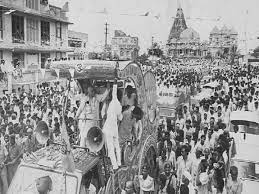
Ram Mandir Movement
Ram Mandir Movement
GS-1: Arts and Culture
(UPSC/State PSC-Uttar Pradesh Special)
Important for prelims
Ram Janmabhoomi-Pran Pratistha, Ayodhya Tourism, Ayodhya Airport, Babri Masjid, Ghaghra River (Saryu River).
Important for mains
About Ram Mandir movement, Ram Janmabhoomi and Babri Masjid dispute, benefits of building the temple, conclusion.
January 19, 2024
Context:
The entire nation is getting ready to see the installation of the statue of 'Ram Lalla' in Ayodhya on January 22, 2024. This will be the culmination of the 'Ram Janmabhoomi' movement, which has been demanding the construction of a temple at the site for decades.
- It is believed to be the birthplace of Lord Ram – and where the Babri Masjid mosque once stood. The movement has also been front and center of the Bharatiya Janata Party's political campaign since its inception in 1980.
- The bitter dispute that gave rise to the Ram Janmabhoomi movement centered on the belief that the Mughal emperor Babur built the Babri Masjid after destroying the temple marking the birthplace of Lord Ram. Followers of this belief say that Lord Rama was born at the exact place where the central dome of the mosque was located. Meanwhile, Muslim organizations protested that the mosque was built in 1528 by Mir Baqi, one of Babur's commanders, without demolishing any place of worship and without transferring the land rights to anyone else.
About Ayodhya:
- Ayodhya, town, south-central Uttar Pradesh state, northern India. It lies on the Ghaghara River just east of Faizabad.
- An ancient town, Ayodhya is regarded as one of the seven sacred cities of the Hindus, revered because of its association in the great Indian epic poem Ramayana with the birth of Rama and with the rule of his father, Dasharatha. According to this source, the town was prosperous and well fortified and had a large population.
About Babri Masjid:
- According to inscriptions on the site, it was built in the year 935 of the Islamic calendar (September 1528–September 1529 CE) by Mir Baqi, possibly a bey serving under the Mughal emperor Babur. Along with the mosques at Sambhal and Panipat, it was one of three mosques constructed in the 16th century upon Babur’s orders.
About the Babri demolition case:
- The location of the mosque has been a source of contention between Muslims and Hindus, the latter asserting that it was built on top of Ram Janmabhoomi, the site they believe to be the birthplace of the Hindu deity Rama. The first recorded instance of conflict over the site between the religious communities was in 1853, during an era of sociopolitical transition throughout India. During the British raj, or direct British rule over the Indian subcontinent, separate areas of the site were set up for Muslims and for Hindus. In 1949, after India was partitioned and became independent, images of Rama were brought into the mosque. In the ensuing controversy, the site was closed off to both communities, but the images were not removed.
- Hindu activists attacking the Babri Masjid (“Mosque of Bābur”) in Ayodhya, Uttar Pradesh, India, December 1992.
- A campaign was launched in 1984 to remove the mosque and build a Hindu temple in its place. The movement gained momentum in the following years, leading to riots in 1990 and the collapse of India’s ruling coalition. This momentum helped sweep the Bharatiya Janata Party to power in several states, including in Uttar Pradesh, and on December 6, 1992, security forces stood by as activists destroyed the mosque. A series of court battles played out in the following decades. Due to decades of tension between Hindus and Muslims, it was destroyed in 1992.
Court’s Decision:
- The land was divided between Hindus and Muslims in 2010 by the decision of a high court. That decision was appealed by both Hindu and Muslim litigants, and in 2019 the Supreme Court entrusted the site exclusively to Hindus.
Benefits of building a temple:
- Increase in tourism: Tourism in the city is likely to increase tenfold after the completion of the construction and development work of Ram Temple in Ayodhya in the year 2024.
- 7,000 people are expected to attend the inauguration of Ram temple. After the temple opens, 3,00,000-5,00,000 visitors are expected each day till next month (February), according to the Ayodhya Development Authority.
- Increase in infrastructure facilities: Ayodhya has been connected with many facilities like modern technology, fast speed and comfortable travel.
- Vande Bharat Express will connect two major temples of Uttar Pradesh - Ram Janmabhoomi and Gorakhnath.
- New Ayodhya Airport: Airlines have been linked to major cities like Delhi, Mumbai, Kolkata, Hyderabad, Bengaluru, Chennai and Ahmedabad to accommodate the lakhs of people who visit the Ram temple every day after the holy event.
- Improvement in economic situation: The economic condition of Ayodhya has improved even before the construction of Ram temple.
- The increasing number of tourists coming to the district has created new employment opportunities for the local people.
- Many new businesses have developed near the temple, offering a variety of native handicrafts to tourists.
Conclusion:
The Ayodhya Ram temple issue was traditionally related to the birthplace of Hindu deity Ram and the location of the Babri Masjid at the same site. Ultimately this issue has been resolved, although many social and political issues related to it remain to be considered.
Source: The Hindu
----------------------------------------
Mains Question
Highlighting the Ram Mandir movement and Babri demolition, discuss the socio-economic benefits of building Ram Mandir.